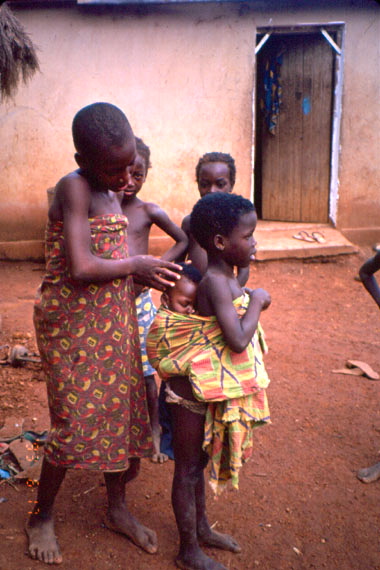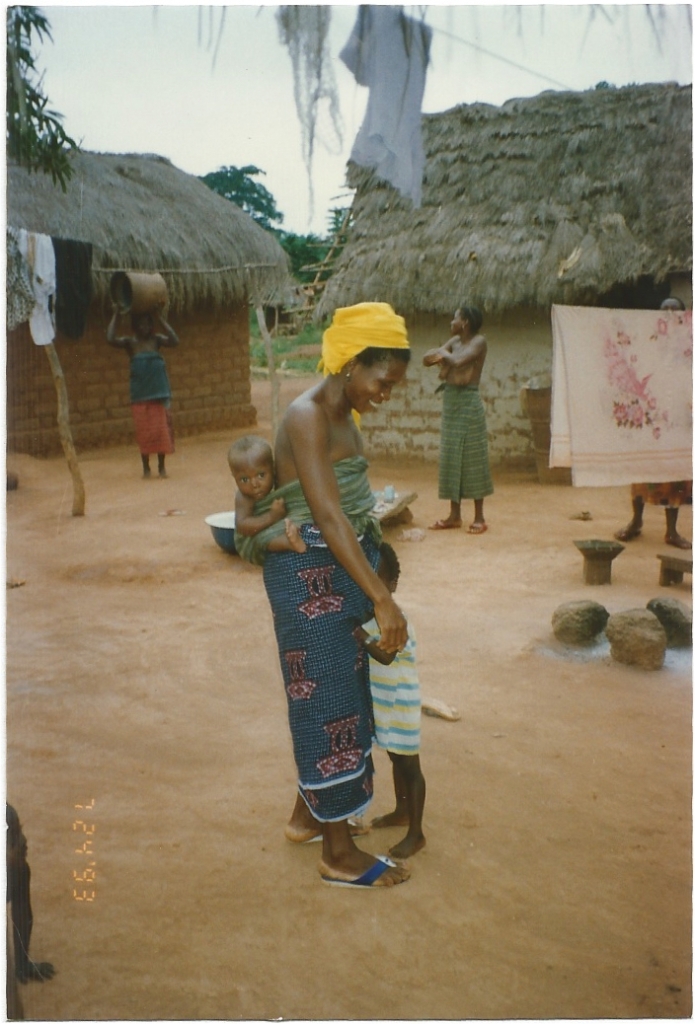In 2004, Alma Gottlieb published a unique ethnography on the babies of the Beng people in Côte d’Ivoire called The Afterlife is Where We Come From: The Culture of Infancy in West Africa. Her work is unique because the majority of ethnographies focus on the culture of adults or verbal children; babies, if considered at all, are typically described in the context of their relationships with adults and older children.

The title hints at the core concept of the infant in Beng culture: reincarnation. The Beng believe that babies are recently incarnated from the afterlife and long to return. So every effort must be made to make the infant feel loved, warm, and comfortable so that it will stay in this life. This also means that they believe infants have a rich inner life, and though unable to speak, infants can communicate through various means, if only the adults are smart enough to understand.

Carrying
Beng infants are typically carried on the back, in a torso-carry, using a simple piece of cloth, like a khanga. Often, the infant is skin-to-skin with the person who is carrying them (see video, below). Mothers often find other people to carry the baby while they work when the baby is around 2-4 months of age. Like the people of Taira, Okinawa in the 1960s, the Beng of the 90s believed that it was not good for the mother’s health to work in the fields with a baby strapped to their backs, especially if they have to walk a long way to the field or care for older children.
“The little one spends much of the day in a vertical position on someone’s back, often napping. Sometimes this back belongs to the baby’s mother, but undertaking very demanding physical labor with a baby attached to her back is not considered optimal for a new mother’s own health, and Beng women recognize that it can also seriously reduce their work productivity,” (Gottlieb, 137).

The Beng call the “baby-sitter” (literally translated means “baby-carrier”) a lɛŋ kũli, which is typically a young girl (as young as five years old) whose job it is to carry the baby, whether the baby is asleep or awake. Ideally, the mother will have many lɛŋ kũli to choose from. The “prettier” the baby, the more girls will want to babysit, however, if a baby were to poo on the babysitter she may not come back.
Potty Training
All Beng mothers dread the thought of their baby defecating on someone. Yet, they do not use diapers. It is considered morally bad for a baby to poo on someone, and a sign of poor mothering and/or an ugly baby. Beng mothers start “potty training” at birth. Unlike other cultures’ infant potty training styles, in which adults train themselves to recognize the baby’s cues or timings, Beng mothers aim to control the infant’s bowel movements. Ideally, the infant would only defecate twice a day, during its bath times, so that it can be properly cleaned. During Gottlieb’s time with the Beng, none of the mothers claimed to have had any difficulty achieving this end. The majority of healthy Beng infants are toilet trained* by the time mothers return to work, between two-four months old.
*Toilet training in the west typically implies that the child is able to tell someone when they need to urinate or defecate, able to take themselves to the appropriate place to do so, remove their clothing and clean themselves (more or less). Toilet training for the Beng means that the infant relieves themselves ( in particular, have a bowel movement) on cue during a specific time of day (bath time) and not while being carried.
This early “toilet training” is very useful to the Beng because infants spend the majority of their lives carried on someone’s back, whether awake or sleeping. In fact, the Beng word for carrier translates to “moving bed” because the infants spend so much time sleeping while carried.
“Developmental psychologists have documented that repetitive motions tend both to lull a wakeful baby to sleep and to encourage a sleeping baby to remain asleep”, (ibid., 174).
Gottlieb’s research found that for 60% of daytime naps, which are never scheduled, babies were in the vertical position attached to someone’s back, and nearly all of the naps recorded took place outside, (ibid., 171-172). Toddlers have learned expect verticality, movement, and connection to another person during daytime naps. Chantal, an articulate two-year-old, explained how his maternal aunt, Little Mama, carries him for nap:
“Little Mama will carry me on her back later while I take a nap in the afternoon”, (ibid., 172).
However, naps are not sacrosanct among the Beng, instead, naps are considered contextually. If the nap is short, it’s short. If the caregiver has to (or wants to) put down a sleeping baby and it immediately wakes, it is not considered a tragedy, nor is there an effort made to get the baby back to sleep. In fact, Beng mothers are more concerned about ensuring they get a nap themselves (especially if the baby kept them up at night) than about when or how long their babies nap (ibid., 177).

Caregivers
Beng babies are passed around frequently from caretaker to caretaker. Gottlieb did a quantitative analysis which showed that the most common length of time a baby spent with one caretaker was a mere five minutes. The infant was passed between 2-6 people throughout the day, being brought to the mother for breastfeeding (ibid., 140-1). Having a lot of caregivers does not necessarily mean there is a lot of attention paid to the baby but this was not the case with the Beng. Wherever the baby is, they are the center of attention with all of their caregivers. There is also a great deal of physical stimulation, at the very least from the positional changes of being handed around to various caretakers, let alone the body-orientated games and songs used to play with the baby.
Considering some people’s concerns that babies being held and/or carried a lot will result in a clingy child, it may be surprising that Beng mothers fear clinginess in their children too. The Beng dread having an unsociable baby or one that has stranger anxiety. They have a special term for this type of baby: gbanɛ. This kind of baby is considered difficult and mothers actively discourage the behavior of clinginess and social anxiety. Gbanɛ babies, because they cannot be left with other people (or other people will refuse to babysit them), inhibit the mother’s ability to work, risking financial hardship and/or reduction of the family’s food supply. Even a small amount of stranger anxiety which, for example, American parents would find normal, the Beng would consider emotionally unhealthy.
Gottlieb created a series of short videos that correspond to the chapters in the book, which can be found here in context, through University of Chicago Press’s page (and on Youtube). Below is the video on Carrying:
If you appreciate this kind of research please consider becoming a Patron of The Baby Historian. It really helps me out and thank you to those already supporting this project. And if you’d like to give your support but can’t afford a financial contribution, sharing and liking your favorite posts on social media (Facebook, Twitter, Instagram) really helps.


3 responses to “The Beng Babies of the Côte d’Ivoire”
So interesting! Loved your article.
LikeLiked by 1 person
[…] also wrote an baby-centred ethnography of the Beng people of West Africa called, The Afterlife is Where We Come […]
LikeLike
Nice poost
LikeLike